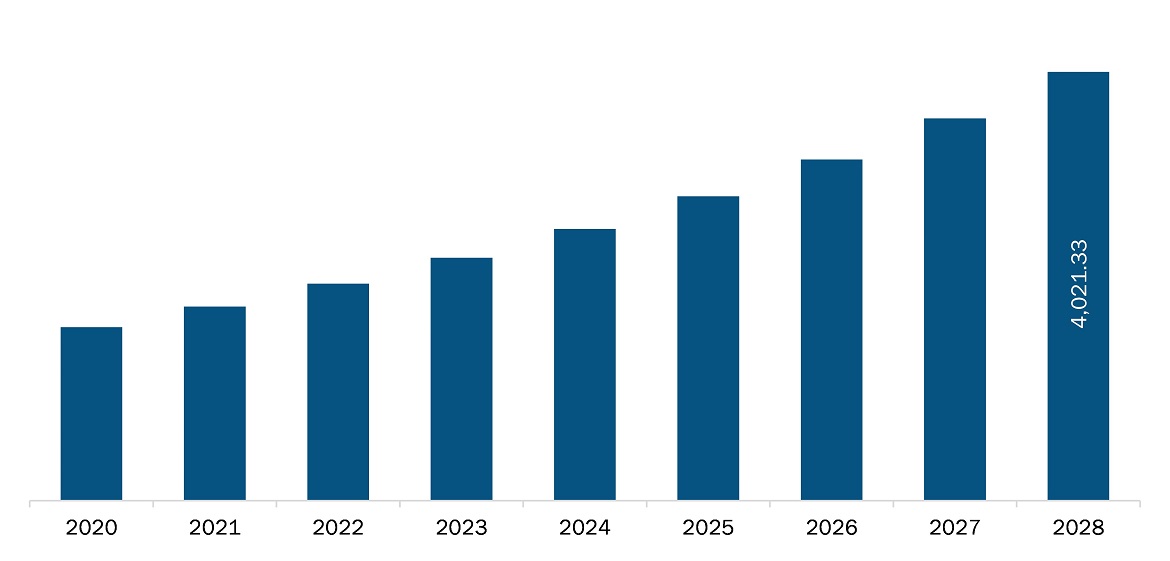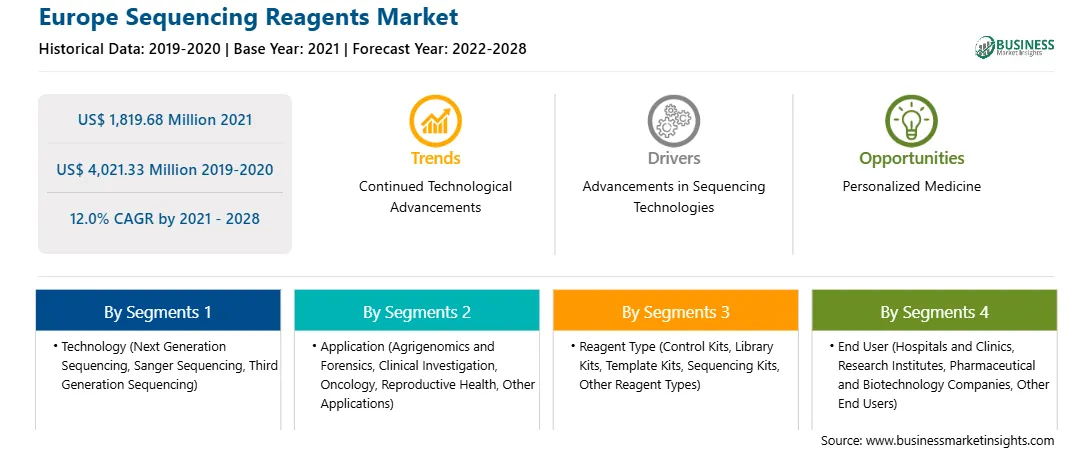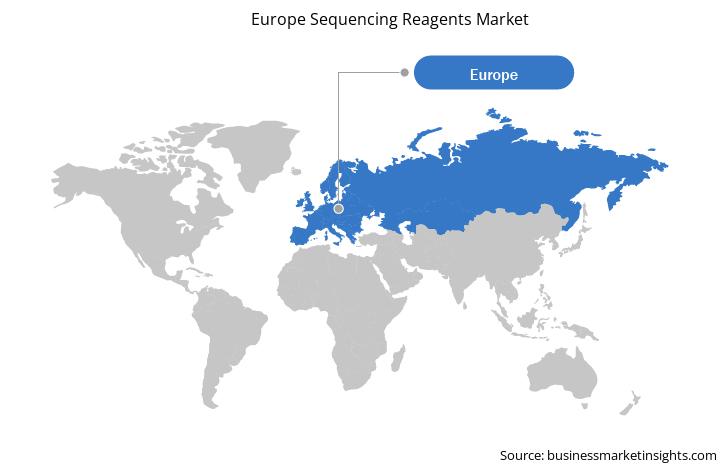Sequencing reagents are used during the process of sequencing. The use of these reagents highly depends on the desired result to be obtained. They form an essential part of the sequencing reactions, which can be used across various other applications as well.

Strategic insights for the Europe Sequencing Reagents provides data-driven analysis of the industry landscape, including current trends, key players, and regional nuances. These insights offer actionable recommendations, enabling readers to differentiate themselves from competitors by identifying untapped segments or developing unique value propositions. Leveraging data analytics, these insights help industry players anticipate the market shifts, whether investors, manufacturers, or other stakeholders. A future-oriented perspective is essential, helping stakeholders anticipate market shifts and position themselves for long-term success in this dynamic region. Ultimately, effective strategic insights empower readers to make informed decisions that drive profitability and achieve their business objectives within the market.

| Report Attribute | Details |
|---|---|
| Market size in 2021 | US$ 1,819.68 Million |
| Market Size by 2028 | US$ 4,021.33 Million |
| Global CAGR (2021 - 2028) | 12.0% |
| Historical Data | 2019-2020 |
| Forecast period | 2022-2028 |
| Segments Covered |
By Technology
|
| Regions and Countries Covered | Europe
|
| Market leaders and key company profiles |
The geographic scope of the Europe Sequencing Reagents refers to the specific areas in which a business operates and competes. Understanding local distinctions, such as diverse consumer preferences (e.g., demand for specific plug types or battery backup durations), varying economic conditions, and regulatory environments, is crucial for tailoring strategies to specific markets. Businesses can expand their reach by identifying underserved areas or adapting their offerings to meet local demands. A clear market focus allows for more effective resource allocation, targeted marketing campaigns, and better positioning against local competitors, ultimately driving growth in those targeted areas.

The Europe sequencing reagents market is expected to reach US$ 4,021.33 million by 2028 from US$ 1,819.68 million in 2021; it is estimated to grow at a CAGR of 12.0% from 2021 to 2028. The growth of the market is attributed to a few key driving factors such as the declining cost of sequencing procedures and the increasing prevalence of chronic diseases. However, the dearth of skilled professionals hinders the market growth.
Sequencing reagents are used during the process of sequencing. The use of these reagents highly depends on the desired result to be obtained. They form an essential part of the sequencing reactions, which can be used across various other applications as well. The cost of genome sequencing has been dropping radically, nearly a million-fold in the past six-seven years. In the recent years, next generation sequencing price have declined substantially. Many of the testing services cost a couple hundred dollars and the lowered cost and higher speed could not only give them a larger margin in profits but the ability to process faster and possibly bring in a higher load of consumers. The rapid reduction in costs has now helped in clinical research, but even greater speed and a lowered price point will likely be enticing to health start-ups for the help of consumers. Hence, major market players such as Illumina and Roche have introduced breakthrough technologies that have enabled the cost and time reduction in the sequencing. Owing to factors such as advances in the field of genomics, development in different methods and strategies for sequencing, there is a notable decline in the cost of sequencing. Additionally, according to the International Diabetes Federation (IDF), the diabetes prevalence among the population is likely to increase by about 35% during the forecast period across globe. As incidence of chronic diseases are increasing at a faster pace, the research on genomics for life-threatening illnesses has progressed rapidly over the last five years, which is driving the market growth.
The rapid growth of COVID-19 confirmed cases in Europe has had a major impact on the European economy. Genome sequencing has increasingly become an important tool for studying disease outbreaks. Many countries have started reporting genomic sequences of the coronavirus from patient samples. The demand for the sequencing kits has been high since the COVID-19 pandemic emerged, thus many companies are increasing their production of reagent kits. In recent days, laboratories in Europe have ramped up genomic sequencing capabilities. The countries in the region are preferring in-house analysis than outsourcing the job. Many private and government organizations are raising funds for sequencing-based studies. Hence, COVID-19 outbreak is propelling the growth of the Europe sequencing reagents market.
The Europe sequencing reagents market, by technology, is segmented into next generation sequencing, sanger sequencing, and third generation sequencing. The next generation sequencing segment held the largest share of the market in 2020. However, the sanger sequencing segment is anticipated to register the highest CAGR in the market during the forecast period.
The Europe sequencing reagents market, by reagent type, is segmented into control kits, library kits, template kits, sequencing kits, and other reagent types. The sequencing kits segment held the largest share of the market in 2020, whereas the library kits segment is anticipated to register the highest CAGR in the market during the forecast period.
The Europe sequencing reagents market, by application, is segmented into agrigenomics and forensics, clinical investigation, oncology, reproductive health, and other applications. The oncology segment held the largest share of the market in 2020. However, the clinical investigation segment is anticipated to register the highest CAGR in the market during the forecast period.
Based on end user, the Europe sequencing reagents market is segmented into hospitals and clinics, research institutes, and pharmaceutical and biotechnology companies, and other end users. The research institutes segment held the largest share of the market in 2020. Also, the same segment is estimated to register the highest CAGR in the market during the forecast period.
A few of the primary and secondary sources referred to while preparing the report on the Europe sequencing reagents market is UK's National Health Service (NHS), World Health Organization (WHO), and German Association of Biotechnology Industries (DIB).
The Europe Sequencing Reagents Market is valued at US$ 1,819.68 Million in 2021, it is projected to reach US$ 4,021.33 Million by 2028.
As per our report Europe Sequencing Reagents Market, the market size is valued at US$ 1,819.68 Million in 2021, projecting it to reach US$ 4,021.33 Million by 2028. This translates to a CAGR of approximately 12.0% during the forecast period.
The Europe Sequencing Reagents Market report typically cover these key segments-
The historic period, base year, and forecast period can vary slightly depending on the specific market research report. However, for the Europe Sequencing Reagents Market report:
The Europe Sequencing Reagents Market is populated by several key players, each contributing to its growth and innovation. Some of the major players include:
The Europe Sequencing Reagents Market report is valuable for diverse stakeholders, including:
Essentially, anyone involved in or considering involvement in the Europe Sequencing Reagents Market value chain can benefit from the information contained in a comprehensive market report.